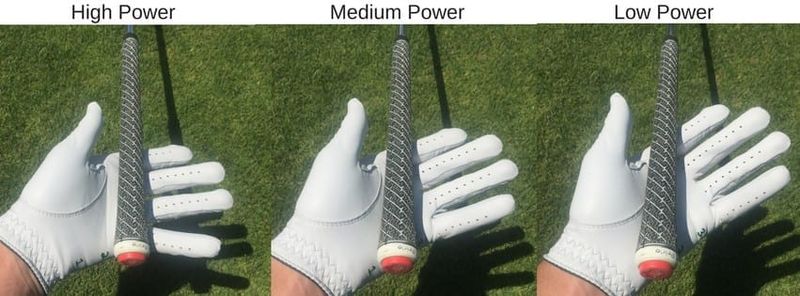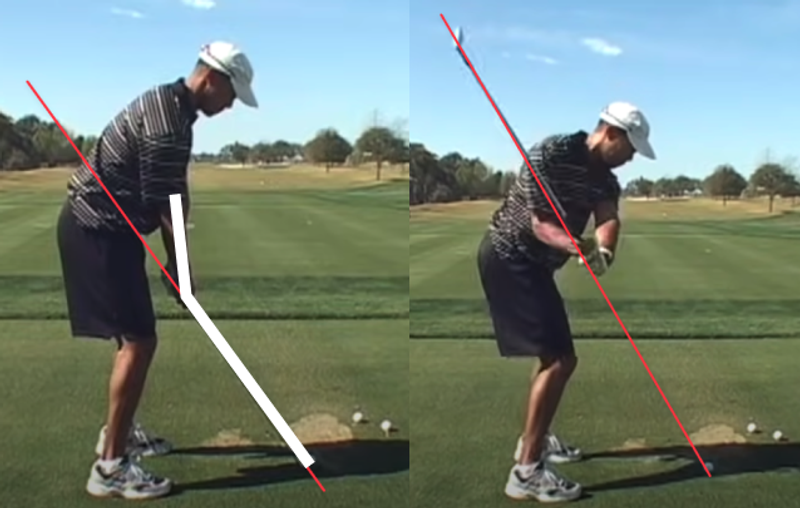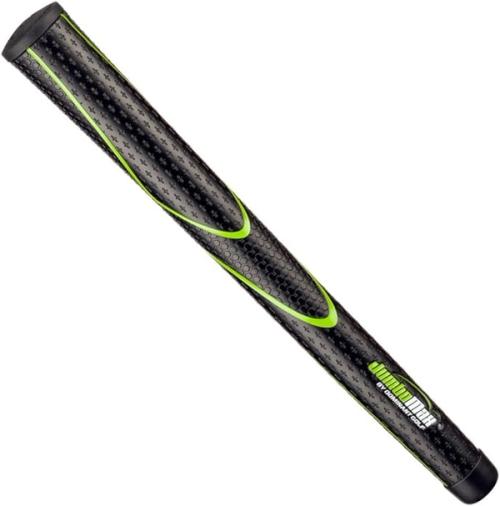We all know Bryson as the "Golf Scientist", but I'll let you in on a secret—his one-plane swing is not a new creation.
It all comes from The Golfing Machine, a book that essentially catalogs all the different ways a golfer can swing a golf club, which ways are compatible with each other, and what outcomes you might achieve with each swing method.
While I can't claim to know the exact thought process behind Bryson's one-plane swing, I do know why he uses jumbo golf grips.
And it's not for the reason most golfers think.
To understand this, we have to dive into a concept you've probably seen before.
The 3 Grip Power Orientations
If you've read my post on the golf grip, you know that in golf, we have 3 "power orientations" that we can use for a golf grip, demonstrated by the Sharpie markings on my glove below:

Most golfers should be using medium or high-power grips. Personally, I recommend the medium, or "neutral" power orientation, and that is what I use.
All three of these orientations are described in The Golfing Machine and describe the relationship between the left arm and the golf shaft.
Power Orientations and Relationship to the Golf Shaft
The greater the angle between the left arm and the golf shaft, the more potential power a golfer can create.
Take a look at Bryson's setup (P1) and downswing (P6) below:

As you can see, the angle created by Bryson's left arm and golf shaft is minimal during the setup.
This is enabled by the fact that he uses a "low power" golf grip.
Notice how the plane angle he addresses the ball at is almost exactly the plane angle he gets back to pre-impact.
Now, let's look at Tiger, who has a medium to high-powered grip orientation. Notice that big angle created between the left arm and shaft at address!

While it's tough to tell with pictures, notice how Tiger's address plane angle is much shallower than his pre-impact plane angle.
In other words, Tiger has shifted plane angles pretty drastically from the setup to the finish. This is the most common way to swing a golf club as it agrees with the natural shape of our bodies and golf equipment.
Bryson's One-Plane Swing Requires Jumbo Grips
I have an activity for you.
Go find a golf club right now and take a "low power" grip. You can reference the photo above, but as a shortcut, you'll know you have a "low power" grip if the grip rests in the palm of your left hand.
Now let me ask you—does that grip feel very secure and stable?
Or does it feel like the grip is going to fall out of your hands?
Unless you have jumbo golf grips yourself, you'll notice that there is a tiny gap created between the grip and your left pinky finger, which makes it hard to hold on to the club.
The only way to achieve this is by making the grips larger.
So the order of operations goes something like this:
1. In order to achieve a "one-plane" swing, you need to maintain a small angle between your club shaft and left arm at address
2. In order to achieve this small angle, you need a "low power" golf grip
3. In order to securely hold a "low power" golf grip, you need larger (or jumbo) golf grips
You can hear Bryson talk about this concept in the video below:
Why Bryson uses a One-Plane Swing with Same Length Shafts
In short, it's about eliminating variables.
- "Zero" plane shift (technically, this is not accurate, but close)
- Constant "aiming point" / "low point" for all clubs
A one-plane golf swing does not shift plane angles throughout, while single-length irons maintain the same "aiming point" (TGM terminology) regardless of what club you're hitting.
Ironically, this should theoretically come at the tradeoff of power (low power grip removes power accumulator #3 (small muscles), but as we know, Bryson doesn't lack that one bit as he maximizes power accumulator #4 (the big muscles).
Should you use Jumbo Grips?
For 9/10 golfers, my answer is NO.
Here are three types of golfers that I would recommend jumbo grips for:
- If you have arthritis in the hands or arms
- If you have HUGE hands (seriously, like giant hands)
- If you're trying to achieve the one-plane swing and are dedicated enough to coach yourself and understand the tradeoffs of this
If you fall into one of those categories, here are the grips that Bryson uses, which you can pair with my tutorial on how to re-grip your golf clubs at home.

The JumboMax golf grips have been around for a long time but were made famous by Bryson Dechambeau. They are light, tacky, and soft.
Concluding Thoughts
I hope you enjoyed today's "golf trivia". While I don't recommend jumbo grips, single-length irons, or a single-plan swing to most golfers, understanding the concepts behind them can go a long way in understanding the golf swing.
Hit 'em straight!
